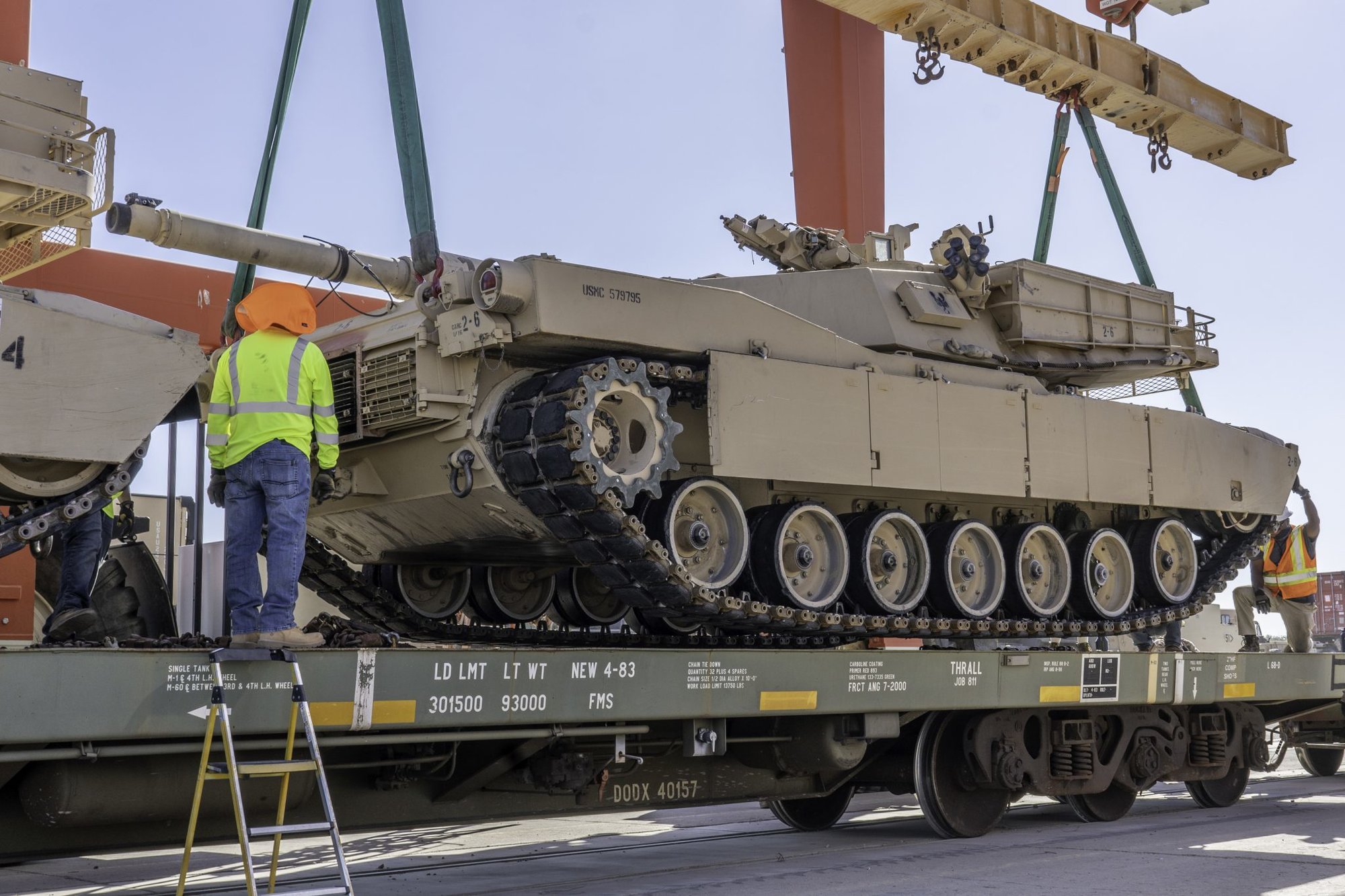Divested 1st Marine Division Tanks, Heavy Equipment Transported to Army Depots

Civilian employees (right) use hand signals to lower the M1A1 “Abrams” tank onto the rail cars aboard Marine Corps Logistics Base Barstow, California, July 7. U.S. Marine Corps photo by Sgt. Jack Adamyk
Laurie Pearson, Marine Corps Logistics Base Barstow
BARSTOW, Calif. — As part of the Commandant of the Marine Corps’ Force Design 2030, nearly 200 M1A1 Abrams Tanks, M-88 Recovery Vehicles, and Armored Vehicle Launched Bridges are moving through Marine Corps Logistics Base Barstow, California throughout this month.
“The tanks currently assigned to 1st Marine Division, Exercise Support Division, Marine Corps Air Ground Combat Center 29 Palms, Marine Forces Reserve and Logistics Command,” said Chad Hildebrandt, Railway Operations supervisor for the base. “They are all being consolidated here at MCLB Barstow for further movement to U.S. Army Depots at Sierra Army Depot in Herlong, California, and to Anniston Army Depot in Aniston, Alabama.”
The movement is being conducted as part of the new United States Marine Corps Force Design 2030 guidance published by General David H. Berger, Commandant of the Marine Corps, March 2020. The 15-page document outlines a plan to modernize the Marine Corps in accordance with the National Defense Strategy, and doing so within the financial means available. It is also being conducted with respect for the history of the Corps.
Keeping fiscal restraints in mind, part of the Commandant’s directive was to use the more efficient and less expensive transport method for moving all of the equipment.
“The Commandant’s guidance was to leverage rail as the primary transportation mode for this divestment where it makes sense.” — Chad Hildebrandt, MCLB Barstow Railway Operations supervisor
“Installations such as Camp Lejeune, North Carolina, Blount Island Command, Jacksonville, Florida, and Marine Corps Logistics Base Albany, Georgia will most likely be shipping their tanks by rail, as well,” Hildebrandt said. “Smaller locations that house tanks for MARFORRES will be making individual decisions based off of rail versus commercial truck use cost analysis.”
The tanks arrive from their various locations to MCLB Barstow by commercial line haul carriers. Once they arrive here, the Railhead Operations Group staff receives the tanks and verifies all documentation and shipping labels are accurate.
“Once that’s done, the tanks are immediately loaded onto railcars,” Hildebrandt said. “We have Marines from several units here to assist with the offload, on load, and securement of the equipment. The loaded cars will be stored on base until we have all tanks loaded and secured, then they will all ship out to the Army at the same time.”
Marines supporting the RHOG movements and controls are from various units
to include:
• Combat Logistics Battalion 11
• 1st
Battalion 5th Marines
• 1st Tanks
• 1st Battalion
1st Marines
• 1st Marine Division.
As the Marine Corps changes from using the heavier tanks and M88s, there is a focus to increase capacities in other areas, such as Rocket Artillery Batteries, Light Armored Reconnaissance companies and active component unmanned aerial vehicle squadrons.

BRCC and Bad Moon Print Press team up for an exclusive, limited-edition T-shirt design!
BRCC partners with Team Room Design for an exclusive T-shirt release!
Thirty Seconds Out has partnered with BRCC for an exclusive shirt design invoking the God of Winter.
Lucas O'Hara of Grizzly Forge has teamed up with BRCC for a badass, exclusive Shirt Club T-shirt design featuring his most popular knife and tiomahawk.
Coffee or Die sits down with one of the graphic designers behind Black Rifle Coffee's signature look and vibe.
Biden will award the Medal of Honor to a Vietnam War Army helicopter pilot who risked his life to save a reconnaissance team from almost certain death.
Ever wonder how much Jack Mandaville would f*ck sh*t up if he went back in time? The American Revolution didn't even see him coming.
A nearly 200-year-old West Point time capsule that at first appeared to yield little more than dust contains hidden treasure, the US Military Academy said.












